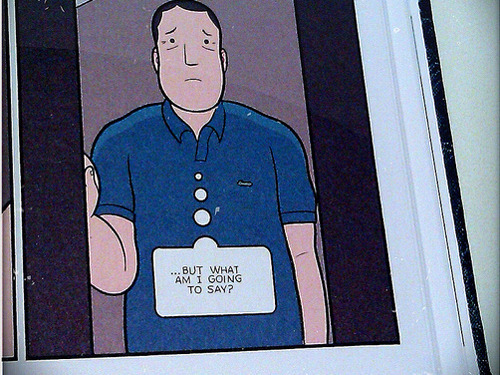The Script Cabins: Writing a Graphic Novel 101

Sure, Script Frenzy may have retired, but we’ve rolled out the red carpet to the Script Cabins at Camp NaNoWriMo. This is the second of our weekly guides for all you future screenwriters, playwrights, and graphic novelists (Read our feature screenplay guide here!):
Itching to bring your very own X-Men to life? Think you’ve got the next Persepolis percolating in your brain? Well then, it’s graphic novel time! By following these simple rules, you’ll be well on your way to becoming the next Chris Ware:
Simple Guidelines to Keep In Mind
A “splash page” is a 1-panel page in a graphic novel: the art inside the panel takes up the entire page. This page is usually reserved for a big reveal or action sequence. Use these judiciously and save them for the most dramatic effect.
Most pages contain 4 - 6 panels, but you can play with this. Writing more than 8 panels per page makes it hard on the artist to properly depict images inside tiny panels.
Whenever introducing a new character, bold and CAPITALIZE that character’s name to make it easy for the artist to see. This signifies that this character is important to the story.
When creating new characters, write every detail you want the artist to convey. If you’re writing established characters, write details only if there’s a change to their appearance in that scene.
When creating your own universe, err on the side of more detail to provide your artist a fool-proof template.
The comic book medium defines the very essence of “show, don’t tell.” If you can propel your story through the art rather than expository dialogue, then do it!
Now that you have the basics laid out, time to prep for the writing of your script!
Read, Read, Then Read Some More
Genres of graphic novels range from your kid-friendly humor books to intricate, adult-targeted stories. Before you attempt to create the next Spidey, read everything you can get your hands on.
Study how many panels there are per page. How much dialogue is in each panel? How much does the art tell the story as opposed to the words? Reading the pros will inform your story-telling and open your mind to new techniques.
Respect the Artist
Comic book writing is an artist’s format above all else, so respect the fact that once you’ve finished building a skeleton, whoever is drawing it, whether it’s yourself or a partner, has to bring it to life.
Don’t fill up your script with so much exposition that the artist won’t get a chance to do what they are great at. Remember, art needs some breathing room.
Outline Your Story
I can’t stress enough how important this is. Because this is such an artist’s medium, you must know what is going to happen page-by-page, panel-by-panel, before you start to write in earnest. I can guarantee if you don’t, you will cram too many panels into one page, or you will miss your page count.
Because you are writing inside of specific space constraints, you need to have a specific idea for how each page will propel your story, and how each panel will aid in that process.
Are you tackling a graphic novel for Camp NaNoWriMo this year?
Adapted from Script Frenzy’s “Intro to Comic Books” guide.
Photo of original art by Chris Ware taken by Flickr user appelogen.be.
Chris Baty's Blog
- Chris Baty's profile
- 63 followers



